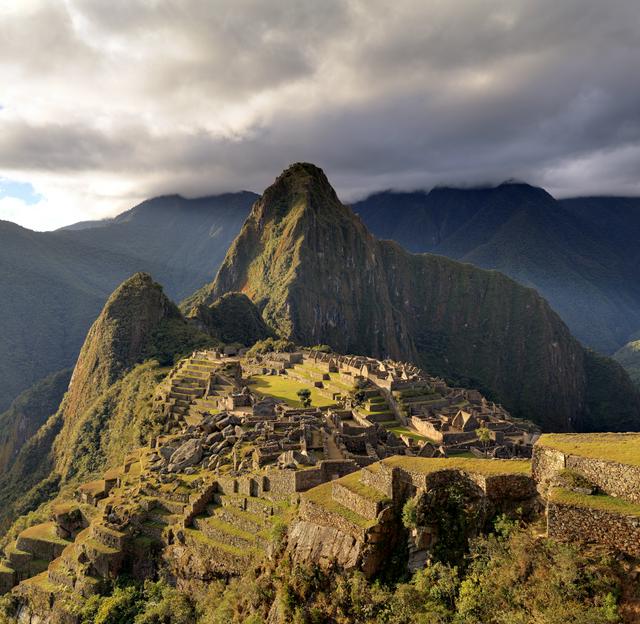
Machu Picchu is the site of an ancient Inca city, high in the Andes of Peru. At 2,430 metres (8,000 ft) above sea level, this is often referred to as “The Lost City of the Incas”, is one of the most familiar symbols of the Incan Empire, and is one of the most famous and spectacular sets of ruins in the world – a visit to Peru would not be complete without it.
These remarkable ruins were rediscovered by the scientific world in 1911 by the American archaeologist Hiram Bingham, who was led to the site by locals. Perched dramatically 1000 ft above the Urubamba river, Machu Picchu is a . It is also the end point of the most popular hike in South America, the Inca Trail.
The story of Machu Picchu is quite a remarkable one; it is still unknown exactly what the site was in terms of its place in Inca life. Current researchers tend to believe that Machu Picchu was a country resort for elite Incas. At any given time, there were not more than 750 people living at Machu Picchu, with far fewer than that during the rainy season. The Incas started building it around AD 1430 but it was abandoned as an official site for the Inca rulers a hundred years later at the time of the Spanish conquest of the Inca Empire.
One thing that is clear is that it was a remarkably well hidden place, and well protected. Located far up in the mountains of Peru, visitors had to travel up long valleys littered with Inca check points and watch towers. Remarkably, the Spanish conquistadors missed the site. However, many people are said to have knowledge of the ancient city as it was referred to in some text found in the 20th century. However, it was not until Bingham that Machu Picchu was scientifically discovered. He was on a trip sponsored by the Yale University, actually looking for the last Inca capital, which was at Vilcabamba, which Bingham also rediscovered but overlooked in favor of the more impressive Machu Picchu.
Machu Picchu was declared a Peruvian Historical Sanctuary in 1981 and a UNESCO World Heritage Site in 1983. In September 2007, Peru and Yale University reached an agreement regarding the return of artifacts which Hiram Bingham had removed from Machu Picchu in the early twentieth century. Since it was not plundered by the Spanish when they conquered the Incas, it is especially important as a cultural site and is considered a sacred place.
Machu Picchu was built in the classical Inca style, with polished dry-stone walls. Its primary buildings are the Intihuatana, the Temple of the Sun, and the Room of the Three Windows. These are in what is known by archaeologists as the Sacred District of Machu Picchu.
Daytime highs are quite constant around the year, but the nighttime lows are much more pronounced during the Southern Hemisphere winter. As is common in the tropics, most of the yearly rain falls during the rainy season which in Machu Picchu isOctober to April. Due to the altitude, extremely hot temperatures that one may expect this close to the Equator are absent. However these two factors contribute to very high levels of UV-radiation (nearby Cuzco actually has the highest average level of UV-radiation in the world for any major city) so do take precautions. its mostly between 12 and 27 °C.
Both are abundant and varied. Typical plant life in the historic reserve of Machupicchu includes pisonayes, q'eofias, alisos, puya palm trees, ferns and more than 90 species of orchids.
The fauna in the reserve includes the spectacled bear, cock-of-the-rocks or "tunqui", tankas, wildcats and an impressive variety of butterflies and insects unique in the region.
The lay of the land, the natural surroundings and the strategic location of Machu Picchu lend this monument a fusion of beauty, harmony and balance between the work of the ancient Peruvians and the whims of nature.
The fee schedule and online tickets are available at the government website and from ticket offices listed on that website. The website is shockingly difficult to use. Reservations made on the website only give you the right to then pay for the tickets — they do not guarantee entry, which is only accomplished after paying for the tickets. The reservations made online are only valid for 2-6 hours, depending on who you ask, and must be paid for either at one of the banks using the code on the reservation, or from one of the other payments means. It is not clear what these means are, however. The safest option is to buy tickets at the Ministerio de Cultura in Cuzco or Aguas Calientes. Whatever you choose, make sure that the confusing website does not end up leaving you with an invalid reservation and hamper your visit.
As of December 2017, the entrance fee for Machu Picchu is US$31 for citizens of Peru, Ecuador, Bolivia or Colombia. For others, it is US$63 in the morning US$44 in the afternoon. For Machu Picchu and Huayna Picchu, it is $48 for Andean citizens, and US$81 for others. There are discounts for children and students with an ISIC card. When preparing your budget, do not forget to include train tickets and bus tickets, and perhaps food at the site.
Most hostels can sell entry permits and bus tickets. Don't buy them at the travel agency at the Ollantytambo train station, as they don't actually sell you tickets, but a receipt that you need to give to a person to get your tickets, you'll end up running all around Aguas Calientes looking for this person. You can buy your ticket at the Aguas Calientes Ministerio de Cultura 05:30-21:00.
Be sure to bring your passport, as it is requested upon entry. Some travelers have been able to enter with other forms of ID. There is a popular stamp booth as you exit where you can prove to your friends you've been there, though in many countries it is illegal to mark your own passport.
Only small packs are allowed in the park (no more than 20 litres), but there is a luggage storage at the entrance (S/5 as of December 2017) mostly used by Inca Trailers. If your pack is checked, any food you carry may be confiscated.
There are no toilets within the site itself, but they are available right outside the entrance and are clean and well maintained. They cost S/2 as of December 2017.
Only 2,500 people are allowed to enter Machu Picchu each day. The government website lists how many tickets are available for each day. Also, visitors must purchase tickets for Huayna Picchu in advance and there is now an additional fee to hike Huayna Picchu.
All the views from above, but be sure before you do it that there are no clouds (early in the morning is always cloudy, It is recommended to do it at noon).
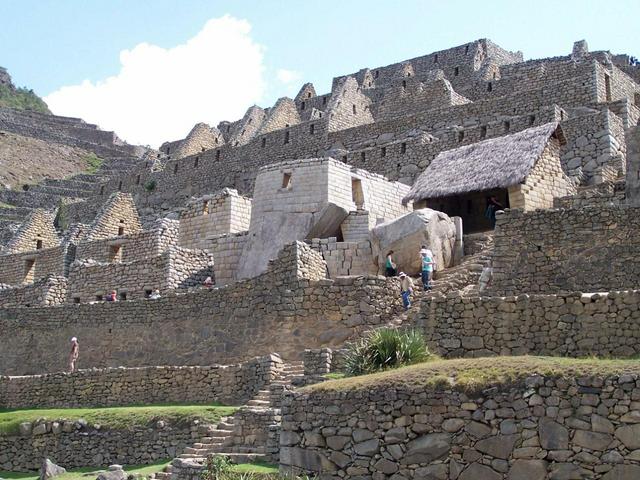 Take your time walking around the site, there are many places to see and explore. Although it is not required, taking a guided tour does provide a deeper insight into the ancient city, its uses, and information on the geography of it. As of Mar 2018, a 2-hr guided tour is S/200, but can be negotiated down depending on how busy the site is. If you wish to save money, you can team up with other tourists who would like to have a guided tour. As a cheaper alternative to a guide, there are several apps providing virtual audio tours of the site.
Take your time walking around the site, there are many places to see and explore. Although it is not required, taking a guided tour does provide a deeper insight into the ancient city, its uses, and information on the geography of it. As of Mar 2018, a 2-hr guided tour is S/200, but can be negotiated down depending on how busy the site is. If you wish to save money, you can team up with other tourists who would like to have a guided tour. As a cheaper alternative to a guide, there are several apps providing virtual audio tours of the site.
Relatively little is known about the history and uses of the ruins, and some of the stories told by the guides are based on little more than imaginative hearsay.
- Sun Gate (Inti Punku) – if you've just arrived via the Inca Trail, this will be your first experience of the ruins. Others can backtrack from the ruins along the trail and up the hill. From here you can see back down each valley offering excellent views, if it is cloudy you cannot appreciate the view (avoid doing it or just wait for a clearance). It's a fairly strenuous hike (probably 1-1½ hours each way) but well worth it.
- Temple of the Sun – Near the summit of the main city, the stonework on the temple is incredible. Look closely and you will see that there are a variety of stone walls throughout the city. Most are rough stones held together with mud, the common stone walls found throughout the world. But many buildings or parts of buildings are done with the more distinctive and impressive closely-fit stonework. The temple is the absolute pinnacle of this technology. Observe it from the side, descending the stone staircase in the main plaza.
- Intihuatana – A stone carved so that on certain days, at dawn, the sun makes a certain shadow, thus working as a sun dial. From Quechua: Inti = sun, huatana = to take, grab: thus grabbing (measuring) the sun. (pronounce 'intiwatana'). While most early risers view the sunrise from the watchtower, the Intihuatana offers the best vistas, and you'll have it all to yourself.
- Temple of the Three Windows –
- Main Temple –
- Temple of the Condor – A temple, including some stones arranged in a way that kind of looks like a condor with wings outstretched, with a prison complex behind it – look closely: between the wings of the condor is a chamber with grooves cut in the stone to secure manacles, a walkway behind where a torturer may walk to whip the prisoner's backs, and a scary looking pit to let the blood of prisoners drain. Clearly the condor was a symbol of cruel justice, but a sanitized version is told for the benefit of tourists.
- Fountains – As a testament to Inca workmanship, these 500-year-old spring-fed fountains still function to this day. It is speculated that these provided drinking water to the city or were for ritual bath purposes.
Sun Gate (Inti Punku) – if you've just arrived via the Inca Trail, this will be your first experience of the ruins. Others can backtrack from the ruins along the trail and up the hill. From here you can see back down each valley offering excellent views, if it is cloudy you cannot appreciate the view (avoid doing it or just wait for a clearance). It's a fairly strenuous hike (probably 1-1½ hours each way) but well worth it.
Temple of the Sun – Near the summit of the main city, the stonework on the temple is incredible. Look closely and you will see that there are a variety of stone walls throughout the city. Most are rough stones held together with mud, the common stone walls found throughout the world. But many buildings or parts of buildings are done with the more distinctive and impressive closely-fit stonework. The temple is the absolute pinnacle of this technology. Observe it from the side, descending the stone staircase in the main plaza.
Intihuatana – A stone carved so that on certain days, at dawn, the sun makes a certain shadow, thus working as a sun dial. From Quechua: Inti = sun, huatana = to take, grab: thus grabbing (measuring) the sun. (pronounce 'intiwatana'). While most early risers view the sunrise from the watchtower, the Intihuatana offers the best vistas, and you'll have it all to yourself.
Temple of the Three Windows –
Main Temple –
Temple of the Condor – A temple, including some stones arranged in a way that kind of looks like a condor with wings outstretched, with a prison complex behind it – look closely: between the wings of the condor is a chamber with grooves cut in the stone to secure manacles, a walkway behind where a torturer may walk to whip the prisoner's backs, and a scary looking pit to let the blood of prisoners drain. Clearly the condor was a symbol of cruel justice, but a sanitized version is told for the benefit of tourists.
Fountains – As a testament to Inca workmanship, these 500-year-old spring-fed fountains still function to this day. It is speculated that these provided drinking water to the city or were for ritual bath purposes.
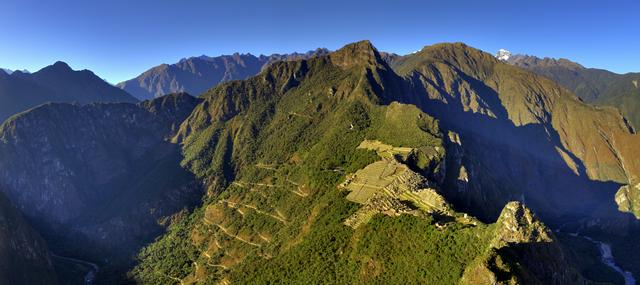
If you got some energy in you, there are a few great hikes involving a bit of legwork. Do make sure that you've taken the time to acclimate to the elevation either in Cuzco or Aguas Calientes for a couple days before exerting yourself too much, especially on Wayna Picchu.
- Huayna Picchu. Towering above the north end of Machu Picchu is this steep mountain, often the backdrop to many photos of the ruins. It looks a bit daunting from below, and it is a steep and difficult ascent, but most reasonably fit persons should be able to make it in about 45 minutes. Stone steps are laid along most of the path, and in the steeper sections steel cables provide a supporting handrail. That said, expect to be out of breath, and take care in the steeper portions, especially when wet, as it can become dangerous quickly. There's a tiny cave near the top that must be passed through, it is quite low and a rather tight squeeze. Take care at the peak, it can be somewhat precarious, and those afraid of heights may want to hang out just below. The entire walk is through beautiful landscape, and the views from the top are stunning, including birds eye views over the whole site. The angle gives you a good sense of the layout of Machu Picchu. There's also a few ruins near the top. Tickets to Huayna Picchu have to be reserved beforehand and are limited to 400 a day - ask the tour company with which you are going to Machu Picchu to reserve this for you (at least a month beforehand). Tickets are purchased in one of two groups: 07:00-08:00 and 10:00-11:00. The later option sometimes has better views as it leaves time for the fog to clear. Entrance to the hike is controlled by a second ticket booth. People start lining up about a half hour or even more before their group is allowed to enter. S/87, added to the price of your ticket.
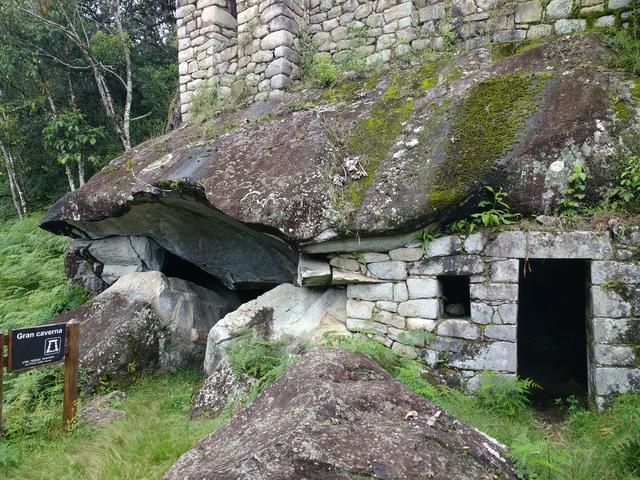
*For serious hikers who have the time and energy and long for a sparkle of solitude, from Huayna Picchu you can continue on an extra hike to the Moon Temple. (Templo de la Luna), which is built into the side of a cave, and the nearby Great Cave (Gran Caverna), where women would come to pray to Pachamama (Mother Earth). This hike is one of your best bets for getting away from Machu Picchu and Huayna Picchu crowds: both sites are much quieter than Machu Picchu and allow you to see Inca architecture at its finest without feeling like you're drowning in other tourists. This longer hike, which goes in a loop and is much more tiring but no more challenging than the regular hike to the peak and back, takes about twice as long: a total of about four hours (three if you're a fast hiker), versus about two hours just to the peak and back. It's a long walk and adventurous hike involving two ladders. Some may find that the sites aren't really rewarding, but unexpected wildlife can be seen (wild spectacled bears have been reported). This hike is also quite interesting because partway through you leave behind the mountain terrain and enter a more conventional forest. The caves can be reached by hiking down the trail from the peak of Huayna Picchu (which includes some semi-harrowing but fun near-vertical descents). Your hike back up from the temples will then be exhausting. Be sure to bring plenty of water and snacks for this long hike.
-PulMc.medium.jpg)
- Machu Picchu Mountain – This is the mountain on which Machu Picchu is located and you can walk to the summit (3040m - Machu Picchu is at around 2,400-2,600m, Macchu Picchu Pueblo (Aguas Calientes) is at around 2,000m). Like Wayna Picchu you will have spectacular views, and it will cost you less. It used to have no entrance fee, but as of November 2017, tickets have to be purchased up front, just like for the site itself. Tickets can be purchased in advance, for one of two groups: 07:00-08:00 or 09:00-10:00. The path to Machu Picchu Mountain can be found along the path to the Sun Gate. Machu Picchu Mountain is among the least visited sites at Machu Picchu, which will give you the opportunity to get away from the tourist crowds. For the round trip you should plan on 2½-3 hours. Bring lots of water, as the hike is strenuous. You are not officially allowed to bring food, but may regret not having some snacks. Expect a hike similar to the one from Macchu Picchu Pueblo to the site in style, but longer, and with steeper steps. The trail is spectacular, even if you don't reach the summit.
- Inca Bridge. Historically there were two paths into Machu Picchu. The Inca Trail is one of the paths, the other is through the Inca Bridge. This bridge (logs/drawbridge) is built across a sheer cliff which would control access to the city. The walk to the Inca Bridge is short and can be found to the south west of Machu Picchu.
Huayna Picchu. Towering above the north end of Machu Picchu is this steep mountain, often the backdrop to many photos of the ruins. It looks a bit daunting from below, and it is a steep and difficult ascent, but most reasonably fit persons should be able to make it in about 45 minutes. Stone steps are laid along most of the path, and in the steeper sections steel cables provide a supporting handrail. That said, expect to be out of breath, and take care in the steeper portions, especially when wet, as it can become dangerous quickly. There's a tiny cave near the top that must be passed through, it is quite low and a rather tight squeeze. Take care at the peak, it can be somewhat precarious, and those afraid of heights may want to hang out just below. The entire walk is through beautiful landscape, and the views from the top are stunning, including birds eye views over the whole site. The angle gives you a good sense of the layout of Machu Picchu. There's also a few ruins near the top. Tickets to Huayna Picchu have to be reserved beforehand and are limited to 400 a day - ask the tour company with which you are going to Machu Picchu to reserve this for you (at least a month beforehand). Tickets are purchased in one of two groups: 07:00-08:00 and 10:00-11:00. The later option sometimes has better views as it leaves time for the fog to clear. Entrance to the hike is controlled by a second ticket booth. People start lining up about a half hour or even more before their group is allowed to enter. S/87, added to the price of your ticket.
Machu Picchu Mountain – This is the mountain on which Machu Picchu is located and you can walk to the summit (3040m - Machu Picchu is at around 2,400-2,600m, Macchu Picchu Pueblo (Aguas Calientes) is at around 2,000m). Like Wayna Picchu you will have spectacular views, and it will cost you less. It used to have no entrance fee, but as of November 2017, tickets have to be purchased up front, just like for the site itself. Tickets can be purchased in advance, for one of two groups: 07:00-08:00 or 09:00-10:00. The path to Machu Picchu Mountain can be found along the path to the Sun Gate. Machu Picchu Mountain is among the least visited sites at Machu Picchu, which will give you the opportunity to get away from the tourist crowds. For the round trip you should plan on 2½-3 hours. Bring lots of water, as the hike is strenuous. You are not officially allowed to bring food, but may regret not having some snacks. Expect a hike similar to the one from Macchu Picchu Pueblo to the site in style, but longer, and with steeper steps. The trail is spectacular, even if you don't reach the summit.
Inca Bridge. Historically there were two paths into Machu Picchu. The Inca Trail is one of the paths, the other is through the Inca Bridge. This bridge (logs/drawbridge) is built across a sheer cliff which would control access to the city. The walk to the Inca Bridge is short and can be found to the south west of Machu Picchu.
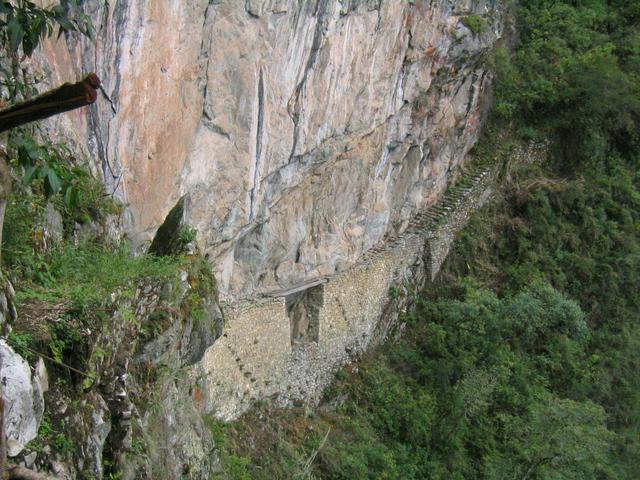 You are not allowed to bring any food into the park, and must check it in at the luggage storage at the entrance. In practice, however, bags are rarely searched, and most people have no problem getting a bottle of water and some snacks in with them, which you'll definitely want, especially if you're planning to stray from the central set of ruins. Buy these beforehand, as they're much more expensive at the site itself. Don't even think of leaving a shred of trash behind you. If you are thinking of walking from 6AM to 5PM, you will need at least 1.5 litres of water.
You are not allowed to bring any food into the park, and must check it in at the luggage storage at the entrance. In practice, however, bags are rarely searched, and most people have no problem getting a bottle of water and some snacks in with them, which you'll definitely want, especially if you're planning to stray from the central set of ruins. Buy these beforehand, as they're much more expensive at the site itself. Don't even think of leaving a shred of trash behind you. If you are thinking of walking from 6AM to 5PM, you will need at least 1.5 litres of water.
The concession stand near the entrance of the site is appropriately overpriced given their captive audience, a meal is US$40, and a small bottle of water is S/8 (in the supermarket it cost S/1). Once in the site, there are no food or drinks for sale, though it is possible to leave and return.
- Tinkuy Buffet Restaurant, +51 84 211038. 11AM–3:30PM. A casual lunch buffet. The food is decent and the restaurant quite busy at peak times. A discounted train and buffet ticket is available on certain trains from Peru Rail. After lunch, do a circuit of the restaurant's poster-size photographs from Hiram Bingham's 1911 "discovery" of Machu Picchu. US$40.
- Tampu Restaurant Bar. 5:30AM-9AM, noon-3PM, 6:30PM-9:30PM. Open to hotel guests only, also high prices.
Tinkuy Buffet Restaurant, +51 84 211038. 11AM–3:30PM. A casual lunch buffet. The food is decent and the restaurant quite busy at peak times. A discounted train and buffet ticket is available on certain trains from Peru Rail. After lunch, do a circuit of the restaurant's poster-size photographs from Hiram Bingham's 1911 "discovery" of Machu Picchu. US$40.
Tampu Restaurant Bar. 5:30AM-9AM, noon-3PM, 6:30PM-9:30PM. Open to hotel guests only, also high prices.
Back to town (in order of size and distance):
- Aguas Calientes – if spending the night or want a bath or another hike
- Ollantaytambo
- Cusco
In the area:
- Sacred Valley
- Inca Highlands
Further afield:
- Kuelap, Amazonas, Northeast Peru – largest pre-Inca ruins in South America
- Tiwanaku, Bolivia – similar stonework, from a different civilization
